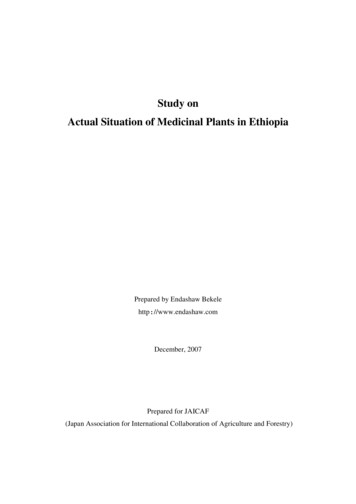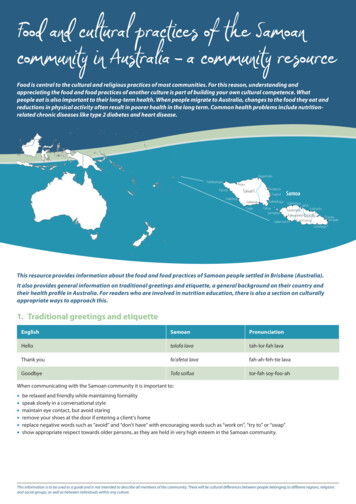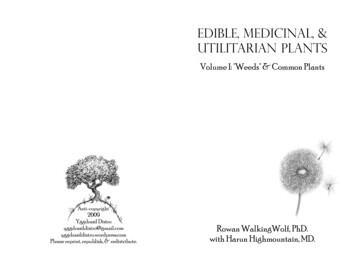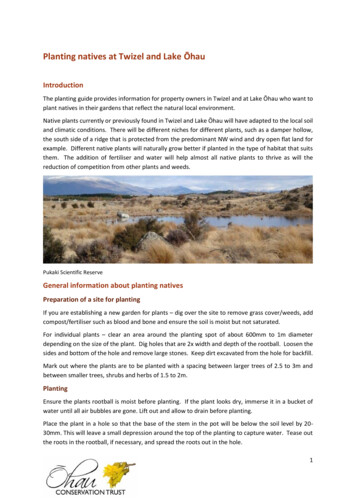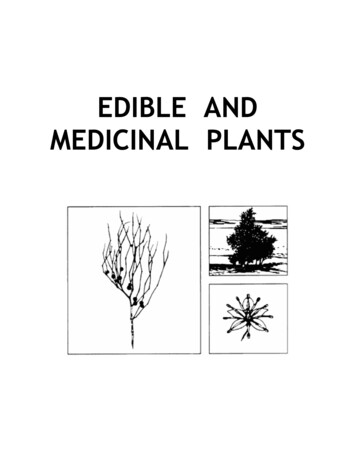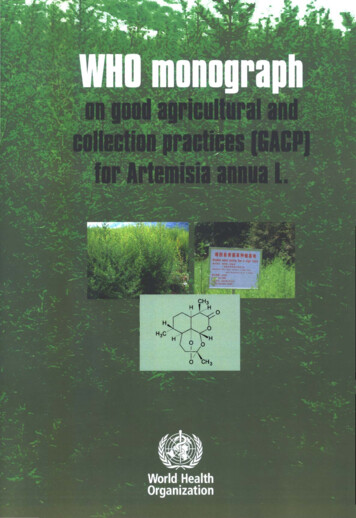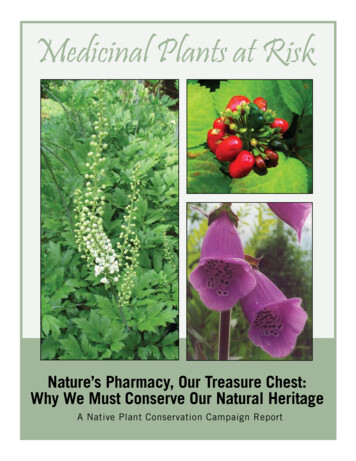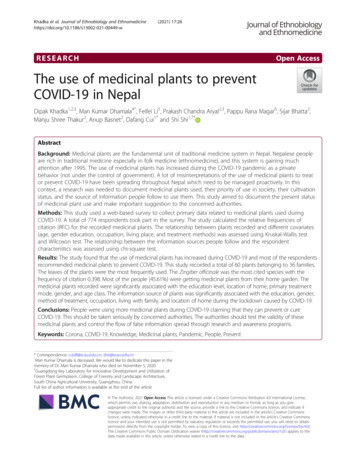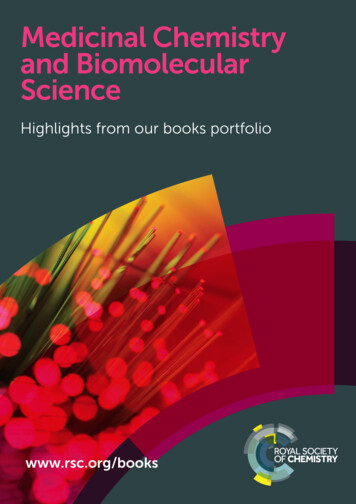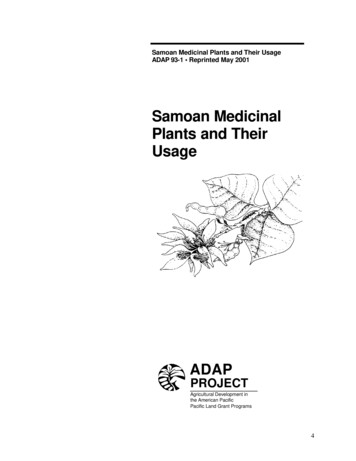
Transcription
Samoan Medicinal Plants and Their UsageADAP 93-1 Reprinted May 2001Samoan MedicinalPlants and TheirUsageADAPPROJECTAgricultural Development inthe American PacificPacific Land Grant Programs4
Samoan Medicinal Plants and Their Usage2001 edition edited and designed by:Luisa Castro, University of Hawaii at ManoaKristie Tsuda, University of Hawaii at ManoaSecond edition prepared by:Michael T. HarringtonCoordinator, Agriculture Instructional Materials ServiceSecond edition illustration by:Petra ScoteseOriginal study conducted, September 1974 by:Charles R. McCuddinDirector, Office of Comprehensive Health PlanningDepartment of Medical Services, American Samoa GovernmentOriginal study funded in part by a grant fromthe South Pacific Commission (Secretariat of thePacific CommunityCopyright 2001 ADAP ProjectThe ADAP Project is a research, extension and instructionprogram of the American Samoa Community College, Collegeof Micronesia, Northern Marianas College, University of Guam,and University of Hawaii.ADAP 93-1Reprinted May 2001ISBN 1-931435-27-8For Further Information:American Samoa Community College 684.699.1575 fax 684.699.5011College of Micronesia 691.320.2462 fax 691.320.2726College of Micronesia (FSM) 691.320.2480 fax 691.320.2479College of the Marshall Islands 692.625.3236 fax 692.625.4699Palau Community College 680.488.2746 fax 680.488.3307Northern Marianas College 670.234.9023 fax 670.234.0054University of Guam 671.735.2002 fax 671.734.5600University of Hawai‘i 808.956.8140 fax 808.956.6967Funded by the United States Department of AgricultureCooperative State Research, Education, and Extension Service Grant 99-38826-7854ADAP Home Office College of Tropical Agriculture and Human Resources3050 Maile Way, Gilmore Hall 213, University of Hawai‘i at ManoaHonolulu, HI 96822 USA www.adap.hawaii.edu/adap adap@hawaii.eduThe Pacific Land Grants and the U.S.D.A. are Equal Opportunity / Affirmative Action Institutionsi
TABLE OF CONTENTSPAGEPreface to the Second Edition .4Definitions.5Background and Historical Perspective.7Objectives.8Methodology.8Knowledge Of Medicinal Plant Usage .8Collection Of Plants .8Preservation Of The Plants.9Identification Of The Plants.9Findings.10Concept of Illness .10Seeking Sources of Help .10Types of Taulasea .11Plant Medicine.11Summary of Samoan Medicinal Plants and Their Usage .12A'atasi.13Aloalo .14Aloalo tai.15Aloalo vao .16'Aoa .17'Apu initia.18Ateate .19Au'auli.20'Aute Samoa.21'Ava.22'Ava'ava aitu .23'Ava niukini .24'Ava pui vao.25Esi .26Fasa .27Fetau .28Filimoto.29Fisoa.30Fu'afu'a.31Fue lau fao .32Fue manogi .33Fue moa .34Fue saina.35Fue sele la.36Fue sina.37Futu .38Gatae.39Ifi.40Ku'ava.41La'au failafa.42Lama .43Samoan Medicinal Plantsii
Lau gasese.44Lau magamaga .45Lau tamatama .45Lau mafiafia.47Leva.48Ma'ali .49Ma'anunu.50Magalo (vi vao).51Magele.52Mago .53Maota (maota o.59Moli'aina .60Moso'oi .61Namulega.62Nonu fi'afi'a.63Nonu vao.64'O'a .65'Ofe Samoa .66Polo fe'u .67Pua .68Pua Samoa .69Seasea .70Sefa .71Soi a .78Togo .79Toi.80To'i to'i .81U.82Usi .83Vao lima .84Vi .85Reasons for Village Healer Preference .86Conclusion .87Appendix: Samoan Illness Names and Treatments. A1Samoan Medicinal Plantsiii
DEFINITIONSNames of IllnessAte fefete – enlarged liverAu pa – jaundiceFa 'a ifo aluga – nasal congestion and sinusitisFa 'ai tiga – sore throatFailele gau – post-partum illnessFiva – feverFua fua 'ini – facial pimples, acneFua fua momono – furuncle in external ear canal or nostrilFula maua – palpable deep abscessGutu malu – thrush, stomatitisI'atolo – furunculosis of the scalpIla – general term for childhood diarrheaIla fa'au tama – birthmarkIla mea – red spot on back of infant’s headIla tatau – birthmarkIla sa – birthmarkLafa – ringwormLanuia – ingestion of mucus and amniotic fluid at birthLavea (naifi) – laceration (with a knife)Lo poto – late arrival of first menstruationMa'i – general term for sicknessMa'i afi – gonorrheaMa'i fulafula – boilsMa'i gau – relapse feverMa'i mata – conjunctivitisMa'i Samoa – Samoan sickness, spirit causedMa'i tafafao – acute mental symptoms, shouting and talking to oneself, sleeplessnessManava le mama – constipationManava mamau – constipationManava tata – diarrheaManava tiga tele – severe abdominal painMata fa – styeMata pa'ia – eye traumaMata tuia – traumatic conjunctivitisMata tolu – children disease of the scalp, falling hair and scabbinessMu – burnMoa lili – cataractMumu – general term for erythremia and cellulitisMumu afi – skin condition with pustules and peeling, leaving a reddened areaMumu ai ivi – intense joint pain and inflammationMumu fau pue – localized cellulites with swellingMumu filogia – hard swelling on any part of the bodyMumu lele – advancing cellulites, (fatal septicemia)?Mumu mageso – redness and itching of the skin, spreadingMumu pae – spreading dark spot usually on buttocks of childrenMumu tatau – sameMumu tuaula – cellulites and septicemiaSamoan Medicinal Plantsiv
Mumu tuaula – head feels swollen, eyes sore, cold sweat, dizziness, numbness of legsPala ga'au – enteritis, usually in childrenPo'o sa – spreading skin sores forming a solid massPua'i toto – vomiting, or coughing up of bloodPuna toto – vaginal bleedingSela – difficulty in breathing, labored breathingSila ilagi – carbuncleSila ilagi – deep abscessSuka – diabetesTale – coughTaliga tiga – ear acheTo'ala fanau – female reproductive organ problemsTo'ala sulu – stomachache with sever lower back pain, hard stomach, possible numbness of legsTu – pterygiumTuia – fish spine puncture woundTulita fasia – urinary tract infectionUa ono – dysuria in babiesUlu tiga – general term for headacheUlu tiga tutui – stabbing or throbbing migraine headacheUmete – deep abscess with feverUtu – mites, liceGeneral termsAi'ile – very young coconut, golf ball to baseball sizedAitu – spirit of dead person, or general spiritFofo – directional message; also, person who specializes in this practiceLapalapa – blunt end of the coconut frondMilimili – gentle stroking of the skinNiu – coconutNiu'ui – green coconutNifoloa – spirit associated with Falelima village in Savai’i, Western SamoaO'o – coconut that has sprouted; also, the white pithy ball inside sameOloa – sickness caused by the spirit of NifoloaPe'epe'e – coconut milkTaulasea – indigenous Samoan healerTipolo – lime tree, or the fruit of the treeTo'ala – general term for female reproductive organs; also used to describe “life essence” felt to residein upper abdomenVaila'au – general term for liquid plant medicineSamoan Medicinal Plantsv
2001 NOTENeither the publisher nor the authors accept responsibilityfor any effects that may arise from using the materialscontained in this manual. The information supplied in thisbook is purely anecdotal and is intended to serve as areference guide to the commonly used medicinal plants inSamoa. This reference guide is not meant to replace the careand information you receive from your doctor or health careprofessionals nor is it to be used for self-treatment ofchronic or acute medical conditions.FOREWARDThe following study of Samoan indigenous medicine was carried out by the Office of ComprehensiveHealth Planning, Department of Medical Services, American Samoa Government during Fiscal Year1974. The study was funded, in part, by a grant from the South Pacific Commission. Sufficient materialhas been collected to afford a comprehensive overview, with some degree of specificity concerning thepractice of ‘bushmedicine’ in American Samoa today.This study could not have been accomplished without the cooperation and valuable assistance of: HCMamea Tiapula, Mr. Molimau Savaiki, Mrs. Nu'u Atuatasi, and HC Aiono Magalei, who were theprinciple sources of first-hand knowledge of indigenous medicine.Special recognition also goes to Mrs. Arieta Mulitauaopele, Associate Health Planner for her abilityto act as the link between the Samoan taulasea (village healers) and the author of this report.Many thanks to the Samoan Medical Officers at the Lyndon B. Johnson (LBJ) Tropical MedicalCenter for their valuable insight and participation, and finally to the CHP Office Staff; Mrs. SalainaTulafono, and Miss Valisa Samuelu for their dedicated efforts and support in the typing of the report.Charles R. McCuddinDirector, CHPFor more rigorous and up-to-date information regarding Pacific Island medicinalplants, please refer to the following publications.Samoan Herbal Medicine: 'O La'Au Ma Vai Fofo O Samoaby W. Arthur Whistler. Paperback - 128 pages (October 1996) Isle Botanica;ISBN: 0964542625.The Ethnobotany of Tonga: The Plants, Their Tongan Names, and Their Uses(Bishop Museum Bulletin in Botany, No. 2)by W. Arthur Whistler. Paperback (October 1991) Bishop Museum Press;ISBN: 0930897579.Polynesian Herbal Medicineby W. Arthur Whistler. Paperback (January 1994) Pacific Tropical Botanical;ISBN: 0915809168.Tongan Herbal Medicineby W. Arthur Whistler. Paperback (January 1993) University of Hawaii Press;ISBN: 0824815270.Samoan Medicinal Plantsvi
PREFACE TO SECOND EDITIONSamoan Medicinal Plants and Their Usage was written based upon the expertise of a small group of wellrespected traditional healers in American Samoa. It was originally published over twenty years ago, in1974. From that time to the present the original text has been in demand, with requests coming to theauthor from many parts of the world. Even in Samoa, it has become rare to obtain a photo-reproducedcopy. For that reason alone producing a second edition has been a worthwhile effort.Additionally, the past two decades have seen a growing interest in natural plant compounds fortreatment of lethal illnesses, including cancer and AIDS. The greatest global diversity of flora is found inthe tropics, and island plants often only exist in their localized area. Yet studies of Pacific Island plantspecies and their uses have been limited until recently. At the same time tropical biotic communities aredisappearing due to needs for land, timber, and other resources. It is hoped that texts such as SamoanMedicinal Plants and Their Usage will inspire a concern for preservation and wise use of our planet'sgenetic heritage.The second edition of this text has been updated for multiple purposes. Most noticeable is theinclusion of illustrations for each of the 74 species in the study. Complimenting the new illustrations isthe revision of names for many of the species. The Samoan and common names remain the same, yetscientific classification of many plants has changed since the first edition. This demonstrates theexpansion of knowledge in the Pacific region as our natural world is studied in greater detail. Althoughlittle of the original text has been altered, a new Conclusions section has been added by the author. Theseadditions should enhance the publication's use in the classroom, as a field guide, and a reference.Many individuals and agencies have contributed to the availability of this second edition. The projectwas initiated by an interest from Mr. Abe Malae, Director of the American Samoa Power Authority. TheAmerican Samoa Power Authority provided the catalyst that was then continued through primary fundingfrom the Agricultural Development of the American Pacific (ADAP) project.The original author, Mr. Charles "Mick" McCuddin, ASG Health Planner; and ethnobotanist, Dr. ArtWhistler, of the UH Manoa Botany Department; both played critical roles in maintaining the integrity ofthe publication. Petra Scotese demonstrated great perseverance as specimens were located and identifiedfor her quality illustrations. Finally, Michael Harrington prepared the publication with great attention todetail assuring that any changes in the second edition were acceptable to all others involved. It is ourhope that this second edition will be useful for another two decades and beyond.Pemerika L. Tauili'ili, Dean and DirectorASCC Land Grant ProgramsSamoan Medicinal Plantsvii
BACKGROUND AND HISTORICAL PERSPECTIVELittle is known about indigenous Samoan medicine before contact with Europeans. At the time of firstcontact, the art of healing was practiced by the Samoan priests who attributed the symptoms of illness topossession by an aitu (spirit of departed person) or its influence, and treatment was directed towarddriving out the aitu or counteracting its effect. This concept of illness was common throughout Polynesia,and is still widely adhered to in Samoa today.The parts of various indigenous plants played an essential role in the treatment process, as didmassage, and the recipes were closely guarded. Even to this day, it is often difficult to learn the truenature of the mixtures being used and the entire process accompanying their administration. It is believedthat many of the medicinal preparations were learned originally from the Tongans, who in turn learnedthem from the Fijians, who were thought to be the most advanced in this art. Kramer, the eminentGerman author who visited Samoa in 1893, recorded some of the plants used for medicinal purposes atthat time. Many of these are still being used.The Samoan people have persevered in their desire to retain traditional values and customs. This isstrikingly apparent in Samoa today in terms of reaction to illness, and its treatment. It is not surprising,since folk remedies and superstition still persist in the highly developed nations in the face of the dramaticscientific technological advances.Traditional patterns are succumbing to the relentless pressures of progress, but when illness threatensvillage healers are often sought out for their local remedies. This is especially so when earlier contactwith scientific medicine has not produced the expected degree of success. A similar phenomenon is seenin the United States, as well as other “developed” countrie s, where persons with incurable disease turn tofaith healers, or other forms of “non-scientific” treatment, as a last resort.In Samoa, where there is not yet a strong universal confidence in scientific medicine, the threshold forturning to alternative methods is much lower. For example, a patient may receive a prescribed medicineat the government hospital and take it home to try for one day, and if dramatic early results are notexperienced, discard the medicine and seek treatment from one of the local taulasea or fofo (traditionalhealer).People who have become dissatisfied with the “government medicine” for one reason or another, areoften prompted to seek help from these “bush-doctors” by another member of the family, usually an olderperson; possibly an aunt, or grandmother, who knows someone who “specializes” in that particularcondition. When ill many people also seek help from these bush doctors for themselves, or their children,as their first source of help.Many feel that there are certain diseases that are unique to the Samoan people, and that these cannotbe treated by palagi medicine (Western medicine). Such illnesses often involve the influence of aitu.Individuals with these illnesses frequently go to the bush-doctors for treatment.For any of a variety of reasons, many Samoans continue to seek out the village bush-doctors inpreference to, or as an alternative to, Western scientific medicine, as rendered by the government ownedand operated LBJ Tropical Medical Center in Faga'alu. There is no use denying this fact, and there islittle to be gained (and possibly much to be lost) by ignoring it. Past attempts to stamp out indigenousmedicine have failed, and further attempts, if carried to extremes, may serve only to drive the practiceunderground. Thus, there are in effect, two medical care disciplines being utilized by the Samoan people:government medicine and indigenous village medicine. An understanding of the interaction of these twodisciplines and the factors involved in the consumers choice of which “system” to patronize, should beconsidered by the Comprehensive Health Planning Advisory Council in its recommendations for theimprovement of the health status of the Samoan people.Recognizing this the Office of Comprehensive Health Planning, in February of 1973, asked for acomplete study of Samoan indigenous medicine. The ultimate goal was to gather and evaluate sufficientinformation to make some rational decisions regarding the potential usefulness of indigenous medicineand its inherent dangers, toward the end of improving the health status of the people of American Samoa.A secondary objective of the study was to record the present state-of-the-art of Samoan indigenousSamoan Medicinal Plants1
medicine in order to preserve some knowledge of this aspect of the Samoan culture that might otherwisebe lost. On May 1973, the Department of Medical Services received a grant from the South PacificCommission to conduct a study of medicinal plants in the Territory.OBJECTIVESThe objectives of this study were to:1. Determine the existing extent of the practice of indigenous medicine in American Samoa.2. Collect, identify, and preserve the plants presently being used in American Samoa for medicinalpurposes.3. Determine how the plant material is being used, including preparation of the medicine and theillness for which it is prescribed.4. Assemble available knowledge of the pharmacological properties of the plants being utilized, andif feasible, arrange for chemical analysis of those plants that have not previously beeninvestigated.5. Attempt to ascertain the relative degree of usefulness of indigenous medicine in treating variousillnesses, and the potential dangers.6. Determine the role of indigenous medicine in the life of the Samoan people.7. Investigate alternative methods of integrating useful aspects of indigenous medicine with thegovernment system of Western medicine.METHODOLOGYKnowledge of Medicinal Plant UsageThrough the efforts of the Associate Health Planner of the Office of Comprehensive Health Planning, fourwell-known and respected taulasea agreed to cooperate in the initial phase of the study. These taulasea(two men and two women) met once a week with the Associate Health Planner and the Director ofComprehensive Health Planning to discuss the treatments and alternative treatments for every Samoanillness they could recall at that time.A subsequent trip to Ta'u, Olosega, and Ofu islands of the Manu'a group brought the study group intocontact with taulasea from that area, who furnished additional information.Collection of PlantsUsing the list of plant names compiled from the treatment information, several of the taulasea went withthe research group into the field where the plants were located, and specimens collected, during whichtime photographs were taken of the plants in their natural habitat. At a later date, a botanist accompaniedthe researcher and a person familiar with the local plants into the field and collected additional specimens.Many specimens were
ADAP Home Office College of Tropical Agriculture and Human Resources 3050 Ma ile Way, Gilmore Hall 213, University of Hawai‘i at Manoa . and information you receive from your doctor or health care professionals nor is it to be used for self-treatment of . Samoan Herbal Medicin
